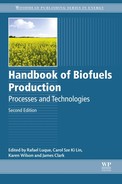Production of bioalcohols via gasification
Abstract
This chapter enlightens and discusses the developments and possibilities in the field of alcohol production via synthesis gas based on biomass feedstocks. The most promising alcohol production technologies based on biomass gasification are believed to be the catalytic and biocatalytic routes. Alcohol production via synthesis gas is common practice for methanol, but not for higher alcohols. A bio-based synthesis gas to methanol process is being performed in the Netherlands in which (waste) glycerin from biodiesel plants is gasified into syngas. An alternative route to produce methanol would be to use methane from biogas as raw feedstock input. Although this looks attractive this has not been done because of existing bottlenecks, being the low prices of natural gas compared to the price of biogas and the lack of availability of large amounts of biogas at one spot. The oxidative coupling of methane (OCM) as an alternative production route for alcohols has been analyzed technically and economically. This process can compete with existing naphtha crackers for producing ethylene, if it is well integrated with a power station infrastructure environment. This OCM process has the extra advantage that it can be operated on a smaller scale, more adjusted to the scale of local production of biogas. In this way fossil CO2-free ethylene (and/or ethane) and fossil CO2-free energy can be produced at the same time, thus opening the road to a fossil CO2-free industry. Via hydration of the C2+ mixture from the OCM process (ethane and ethylene) ethanol can be produced. Finally higher alcohols can also be produced via the ethylene route, like ethylene glycol and propanediol, making these alcohols also bio-based. The main bottleneck for bio-based ethanol production via the OCM route remains the production and availability of biogas and the integration into an existing energy using infrastructure.
Keywords
Bio-based alcohols; Biomass; Gasification; Higher alcohols; Oxidative coupling of methane; Synthesis gas16.1. Introduction
16.2. Gasification routes for alcohol production
16.2.1. Methanol production
16.2.2. Ethanol production
C2H4 (g) + H2O (g) ↔ C2H5OH (g) ΔH = −43.4 kJ/mol[16.1]
C2H5OH (g) + C2H4 (g) ↔ C2H5OC2H5 (g)[16.2]
2C2H4 (g) + H2O (g) ↔ C4H8 (g) + H2O (g) ↔ C4H9OH (g)[16.3]
C2H4 + H2SO4 ↔ C2H5OSO3H ΔH = − 60 kJ/mol[16.4]
C2H4 + C2H5OSO3H ↔ C2H5OSO2OC2H5[16.5]
C2H5OSO3H + H2O ↔ C2H5OH + H2SO4[16.6]
C2H5OSO2OC2H5 + H2O ↔ C2H5OH + C2H5OSO3H[16.7]
C2H5OSO2OC2H5 + C2H5OH ↔ C2H5OC2H5 + C2H5OSO3H[16.8]
CH3OH + CO ↔ CH3COOH ΔH = −138.6 kJ/mol[16.9]
CH3COOH + 2H2 → C2H5OH + H2O[16.10]
![]() [16.11]
[16.11]
![]() [16.12]
[16.12]
![]() [16.13]
[16.13]
16.3. Technical and economical analysis of the oxidative coupling of methane process
16.3.1. Introduction
![]() [16.14]
[16.14]
16.3.2. Technical analysis
16.3.3. Economical analysis
Table 16.1
Design assumptions of oxidative coupling of methane (OCM) process
| Reaction parameters | OCM reaction |
| C2+ selectivity (per reactor passage) | 80% |
| Conversion (per reactor passage) | 30% |
| C2+ yield | 24% |
| Energy yield | 140 MW |
| Energy yearly yield | 4.4 PJ |
| Ethylene yearly production | 180,000 t |
| Natural gas yearly input | 300,000,000 m3 |
Table 16.2
Overview of the ethylene production costs oxidative coupling of methane (OCM) process and naphtha cracking including separation costs
| Costs (million Euros) | Costs per ton ethylene natural gas | Costs per ton ethylene green gas | Costs per ton ethylene naphtha a |
| Resources | 637 | 1048 | 1056 |
| General expenses | 30 | 30 | 83 |
| Indirect costs | 37 | 37 | 262 |
| Utilities | 23 | 23 | 0 |
| Depreciation (10 year, 4%) | 216 | 216 | 271 |
| Labor costs | 42 | 42 | 72 |
| Total | 985a | 1396a | 1744a |

Table 16.3
Prices of resources and products
| Price (€/kg) | |
| Oxygen | 0.01 |
| Ethylene | 1.01 |
| Natural gas | 0.37a |
| Green gas | 0.70 |


